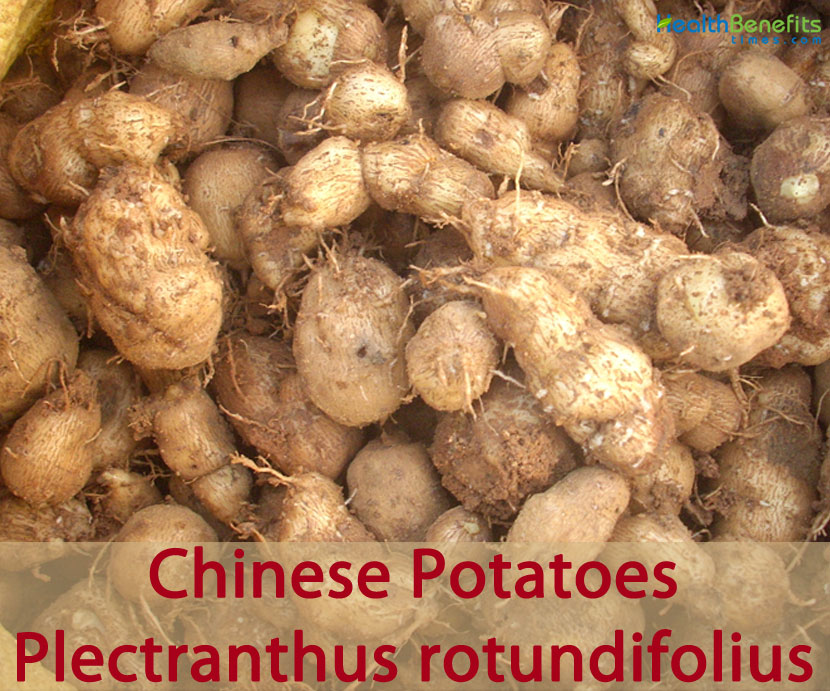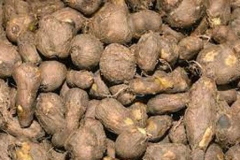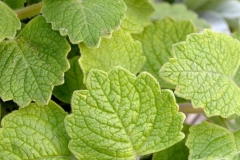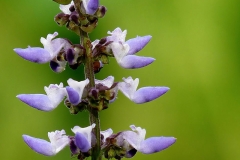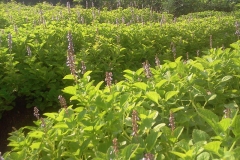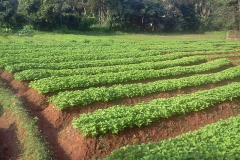| Chinese Potatoes Quick Facts | |
|---|---|
| Name: | Chinese Potatoes |
| Scientific Name: | Plectranthus rotundifolius |
| Origin | Madagascar, tropical and southern Africa, Sri Lanka, India, Malaysia and Indonesia |
| Colors | Blackish, brownish, reddish-grey or whitish (Tuber) |
| Shapes | Egg -shaped, potato-like tubers usually 2 – 4 cm long, occasionally to 8 cm, occurring in clusters of 3 – 7 at the base of the stem (Tuber) |
| Taste | Peculiar tuber taste |
| Health benefits | Heart health, Cancer, Dysentery, mouth and throat infection, abdominal pain, wounds and burns |
| Name | Chinese Potatoes |
|---|---|
| Scientific Name | Plectranthus rotundifolius |
| Native | Tropical Africa. It is cultivated for its edible tubers primarily in Madagascar, tropical and southern Africa, Sri Lanka, India, Malaysia and Indonesia throughout continental Asia to Peninsular Malaysia, Sumatra, Java, and the Moluccas and possibly in the Philippines |
| Common Names | Hausa potato, Madagascar potato, Chinese-potato, Salaga-potato, Sudan-potato, Country-potato, Fra-fra-potato, Coleus, coleus potato, Kafir potato, Zulu potato, native potato, Zulu round potato, fabourama, koorka |
| Name in Other Languages | English: Hausa potato, Madagascar potato, Chinese-potato, Salaga-potato, Sudan-potato, Country-potato, Fra-fra-potato, Coleus, coleus potato, Kafir potato, Zulu potato French: Pomme de terre de Madagascar, Pomme de terre du Soudan, Pomme de terre d’Afrique German: Hausakartoffel, Madagaskar-Kartoffel Hindi: Kukra, koorka Indonesian: Kentang hitam, Jawa, or kleci Javanese: Kenthang kleci, kentang ireng Kannada: Saṃbrāni (ಸಂಬ್ರಾಣಿ), sambrali (ಸಂಬ್ರಾಲಿ) Konkani: Kook (कूक), Jhade Kanaga (झाड़े कणगा) Malay: Ubi kembili, Ubi keling, Kentang Jawa, Kentang ireng, Ubi keling Malaysia: Ubi kembili, ubi keling Malayalam: kūrkka (കൂർക്ക), kūrkka, koorka, koorkka Portuguese: Cóleus, batateira-do-sudão, ratala Sinhala: Innala (ඉන්නල), ratala Spanish: Patata de los Hausas Sudanese: Huwi kentang Tamil: Cṟu kiḻaṅku (சிறுகிழங்கு), siru kizhangu Thai: Man khinu (มันขี้หนู), Man nu, Man Khee Nuu, Man Nuu |
| Plant Growth Habit | Aromatic, semi-succulent perennial herbaceous plant |
| Soil | Crop cannot stand waterlogging and prefers a well-drained sandy loam, but can tolerate a range of soils and heavy clays are unsuitable |
| Plant Size | Up to 1 m tall |
| Stem | Stem is up to 15-30 cm in length, decumbent or ascending, quadrangular, with densely pubescent on the angles and roots at the nodes |
| Tuber Shape And Size | Egg -shaped, potato-like tubers usually 2 – 4 cm long, occasionally to 8 cm, occurring in clusters of 3 – 7 at the base of the stem |
| Tuber Color | blackish, brownish, reddish-grey or whitish, with rough skin |
| Leaf | Leaves, oval, toothed, sometimes carrying a scarlet spot in the center of the blade, are arranged in an opposite-decussate manner (the pairs of successive leaves form an angle of 90 °). |
| Flowering season | February and August |
| Flower | Bilaterally symmetrical flowers of the bilabia type are about 1.5 cm long and vary in color: red, purple or yellow. They are grouped together in terminal clusters that appear before the leaves. |
| Fruit Shape & Size | Fruit consisting of 4 nutlets, but rarely developing |
| Propagation | By tubers, suckers or soft-woody stem cuttings |
| Taste | Peculiar tuber taste |
| Plant Parts Used | Tuber |
| Health benefits |
|
| Other Facts |
|
| Precautions |
|
Plant Description
Chinese Potatoes is an aromatic, semi-succulent perennial herbaceous plant that normally grows up to 1 m tall. The plant cannot stand waterlogging and prefers a well-drained sandy loam, but can tolerate a range of soils and heavy clays are unsuitable. It is an herb with prostrate or ascending habit and a succulent stem reaching up to 15-30 cm in length, forming tubers in clusters around the base of the stem. The tubers are small and dark-brown. The stem is decumbent or ascending, quadrangular, with densely pubescent on the angles and roots at the nodes.
Tubers
The plant produces egg -shaped, potato-like tubers usually 2 – 4 cm long, occasionally to 8 cm, occurring in clusters of 3 – 7 at the base of the stem. They are blackish, brownish, reddish-grey or whitish, with rough skin. The plant forms new tubers in clusters around the bases of the stems.
Leaves
The leaves are rather thick, juicy, faintly aromatic when bruised and arranged oppositely. The petiole is 3-5 cm long and puberulous. The blade is ovate to sub-orbicular, measuring 2-6 cm long and 1.5-4 cm wide, wedge-shaped at the base, coarsely crenate at the margins, puberulous at the apex and with gland-dotted below.
Flower
The inflorescence is a terminal false spike, measuring 5-15 cm long, with distant whorls of 4-6 flowers. The flower-stalk is 1-2 mm long. The bracts are small. The sepal is bell-shaped, measuring 1.5-3 mm long, glandular-hairy and 5-toothed. The upper tooth is oblong, pointed and very short median teeth with rounded tip while the lower teeth is highly fused that forms an almost flat tip but ends abruptly in 2 widely apart acute tips. The flower is tubular and 2-lipped, measuring 7-12 mm long, light to dark violet, velvety and gland-dotted. The tube is strongly curved. The upper lip is very short and with 4-lobed while the lower lip is boat-shaped. There are 4 stamens that curved within the lower lip. They are up to 2.5 mm long; shortly unite at the base and envelope the style. The style is 2-fid and slightly exceeding the stamens. Flowering occurs between February and August. Normally the crop reaches maturity in 5-8 months.
Fruit
Fertile flowers are followed by fruit consisting of 4 nutlets, but rarely developing.
Health benefits of Chinese Potato
Listed below are some of the well-known health benefits of Chinese Potato
1. Heart health
The Chinese Potato is an aromatic herb that affects heart contractions and blood clotting. It also lowers blood pressure.
2. Anticancer
The Hausa potato has a cytotoxic and anti-tumor promoting activity, which can be used to treat cancer.
3. Dysentery
In Ghana, dysentery is treated with Chinese Potatoes. Leaves are boiled, and drank or groundnut paste added to it to make a meal for the sick person. Potatoes are also cooked with the peel, filtered and drank at intervals of help with diarrhea or dysentery. This not only stops dysentery, but it also energizes the person.
4. Digestive problems
Leaf is used to treat a wide range of digestive issues including, bloating and abdominal discomfort.
5. Respiratory problems
Chinese Potatoes has an antispasmodic action, making it valuable in treating respiratory complaints, including asthma and bronchitis.
6. Skincare
The leaves have a strong camphoraceous aroma and are used as a body rub to cleanse, deodorize the skin, and treat skin conditions.
Traditional uses and benefits of Chinese Potatoes
- Leaves are occasionally used in traditional medicine for purposes such as the treatment of dysentery.
- The plant is also used to treat blood in the urine as well as eye disorders.
- They are also used against dysentery and certain eye diseases in Africa.
- Leaves of Chinese potatoes are often used for treatment of dysentery.
- Chinese potato is helpful in treating conditions like vomiting, diarrhea, mouth and throat infection, abdominal pain, wounds, burns, insect bites and other sensory disorders.
- In ethno botany, preparation of boiled leaves of Hausa potato is used to treat blood in urine and eye disorders including
- It can also improve immunity and body’s defense mechanism.
Culinary Uses
- Aromatic tubers are eaten as a delicacy, cooked or steamed, often with rice.
- Tubers can be consumed raw or cooked.
- The tubers are made into alcoholic drinks.
- Young tubers (white) are often used in soups or in vegetable dishes.
- They are cooked with spices in various combinations with other foods such as beans and cooked vegetables.
- They are eaten cooked or steamed as a vegetable, sometimes even raw; they are also mixed with savor.
- Leaves can be cooked and occasionally used as a vegetable.
- Meal made from adult tubers is used in Indonesia as a substitute for Irish potatoes in the preparation of minced-meat balls, or cooked with palm sugar and coconut milk.
Storage of Chinese Potatoes
Chinese Potatoes are difficult to store. Traditionally the tubers are stored in the ground under a tree where it is cooler than in the open. When stored in this way under hot conditions the special taste of Chinese potato usually lasts for two months only, after which the tubers become bland and are no longer considered a delicacy. Chinese potato is also packed in bags or baskets stuffed with straw, but if these are kept under warm conditions the tubers will soon shrivel and are no longer edible. To keep the tubers longer, people put them in pots sealed with cow dung. The small tubers needed for the next planting season are stored in this way. In cooler conditions, such as in highland regions or in South Africa, storage is easier.
References:
https://www.itis.gov/servlet/SingleRpt/SingleRpt?search_topic=TSN&search_value=833087#null
https://www.cabi.org/isc/datasheet/98877340
http://tropical.theferns.info/viewtropical.php?id=Plectranthus+rotundifolius
https://en.wikipedia.org/wiki/Coleus_rotundifolius
https://indiabiodiversity.org/species/show/266273
https://uses.plantnet-project.org/en/Plectranthus_rotundifolius_(PROSEA)
https://davesgarden.com/guides/pf/go/205983/#b
http://www.theplantlist.org/tpl1.1/record/kew-158453
https://www.flowersofindia.net/catalog/slides/Chinese%20Potato.html
https://apg.pir.sa.gov.au/gringlobal/taxonomydetail.aspx?id=317408
https://gd.eppo.int/taxon/CXURO
https://plants.usda.gov/core/profile?symbol=SORO5


